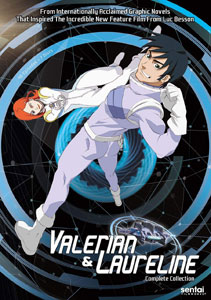Whether it’s because I’m more used to the show’s rhythms or because the scripts are getting better, I enjoyed episodes 11-20 more than the first 10 episodes of “Time Jam: Valerian & Laureline.” These aren’t the comics’ Valerian and Laureline, who love each other and don’t make a big deal about it. These versions of V&L are melodramatic; every time a second male is in the story, we get a love triangle because of Valerian’s itchy-trigger-finger jealousy.
But when the other person isn’t in the room, we get several examples of proof that they do love each other. In “There’s No Time” (episode 16), for example, Valerian has an entire romantic plot with Laureline’s descendant of the same name in an alternate world where he didn’t rescue Laureline in 912 feudal France. And in “Sign of the Times” (15), “Time Jam’s” best episode so far, Valerian admits to her face that he’s happy Laureline is staying with him, after it looked as if she’d go her separate way.
The writers don’t seriously build on that moment, though. It’s clear they want to maintain this not-quite-a-couple dynamic throughout the 40 episodes. I’m mostly OK with that.
These 10 episodes still have the problem of being awkwardly paced. A big moment, like the defeat of the villain, will happen in the blink of an eye whereas a small moment, like Valerian stretching in his pilot’s chair, will be dragged out. Because of this, the plot machinations are sometimes hard to follow. That’s somewhat true of the Christin and Mezieres comics, too, but the convoluted storytelling is more purposeful when they do it.
Most of the episodes center on a strong theme or moral message. In the excellent “Sign of the Times,” Laureline becomes a popular advertising pitchwoman. It perhaps inspired “Shingouzlooz Inc.,” the 2017 comic by Wilfrid Lupano and Mathieu Lauffray. In the TV episode, Laureline voluntarily takes the job, then her employers (backed by the shadowy Gork Yodol of the Vlagos Empire) make political ads with her image and voice, without her approval. In the comic, where Laureline is stronger-willed, the villain flat-out steals her likeness and mass-produces dolls.
“Time Jam” is ahead of the comics in terms of making Laureline universally beloved. She’s a little too well developed and grounded to be a Manic Pixie Dream Girl. It’s just that everyone loves her, from that one Shingouz with hearts in his eyes to at least two princes. In “Time of Troubles” (20), Prince Baral of the Aldebaran seems to have a thing for our gal, and so does Cyrfranu, the prince of Aspara, in “A Race Against Time” (19). Valerian is a bit too in the guy-who-can’t-do-things-right mold for my tastes, but crucially, he always comes through in the end rather than becoming a punchline.
In “It’s About Time” (17), “Time Jam” zeroes in on its central premise for the first time: The question of what happened to Earth. With Asimovian overtones, V&L travel to the solar system and land on the moon, which is now orbiting Mars. There they meet a band of resistance fighters against the Vlagos – including a member of the Vlagos race (!) – who are not only planning their next move, but also guarding a data archive. Beloved comics character Mr. Albert makes his debut, weirdly telling Valerian that he and the galaxy are better off if he doesn’t research Earth’s disappearance.

At least he and Laureline can rest easy that his rescue of her in 912 did not lead to the disappearance of the Earth; that happened in the 2020s, soon after the moon base was established. But that’s four centuries before Valerian was born, something he thinks is impossible, although it struck me as a simple case of “different timelines.”
The formula of Yodol pestering V&L on every random adventure (and vice versa) is well established by now, and episode 20 (a midseason finale of sorts) ends with Yodol receiving an order from his superior: Monitor V&L but don’t kill them, because the Vlagos need to learn more about the mysterious Earth; it’s the key to the race’s desired galactic domination. It’s all a bit vague, but I’m confident answers are forthcoming.
The standalone plots are even better than the overall arc. In “Tea Time” (11), our heroes switch bodies. The laughs are on the surface (Laureline: “Why is my face scratchy?”), as the writers miss a chance for the duo to gain empathy for one another from the experience, but it still provides chuckles.
“As Time Goes By” (12) seems most directly aimed at comics fans of any episode to this point. The “Westworld”-esque plot where V&L are in a hologram world of the Old West is adult-oriented, and we meet a Grumpy Transmuter from Bluxte. He’s called Melo in the movie, but Cookie here, and he vomits up copies of what he eats rather than pooping them out.
“On Borrowed Time” (13) might’ve inspired the start of Luc Besson’s movie, as V&L are enjoying a beach vacation only to be interrupted by an emergency: The beach world’s sister planet is going to crash into it. (Again, Gork Yodol is behind it.) We meet another comics fave, Ralph the peaceful math-genius Glapum’tian. Unlike in the comic, he doesn’t speak in the cartoon, instead making blue-whale-like sounds. Our heroes – particularly Laureline, who loves interesting creatures as much as Newt Scamander — can generally understand and respond to Ralph’s sounds. For some reason, it works.
“Time and Tide” (14) introduces the comics’ Rigor Mortis Quartet, who at first are easily dispatched with a few gymnastics moves by Laureline. In “Time of Troubles,” though, their psychic abilities will prove a serious threat.
“Serving Time” (18) and “A Race Against Time” are weaker episodes. They are political satires of sorts: In the latter, the winner of a spaceship race will win the throne of a planet’s government. In the former, Valerian is caught in “Brazil”-style bureaucracy on an ice planet, but the satire is overshadowed by the attempted comedy of Valerian constantly sinking into the ice, as his spacesuit has a built-in warming mechanism.
I wouldn’t describe any of these episodes as tight; even the best ones are a bit clunky. Yet they are all some degree of fun, just because I like Valerian and Laureline, their banter and their heroic deeds. At this point, “Time Jam’s” internal clichés are becoming part of the charm, pairing nicely with the fact that the standalone adventures always offer an inventive plot and theme, much like the comics.
More “Time Jam” reviews:
Click here for a complete index of “Valerian and Laureline” reviews.

